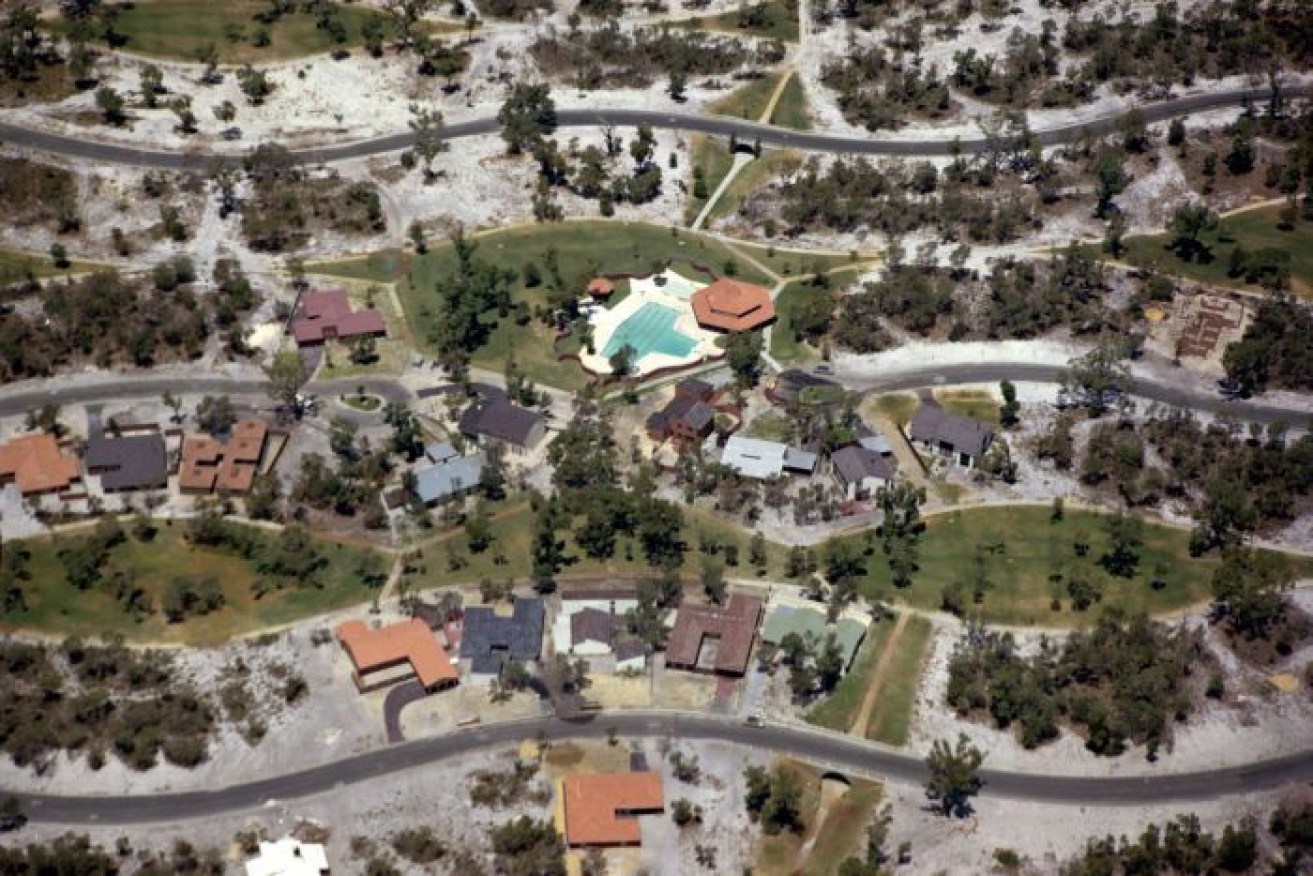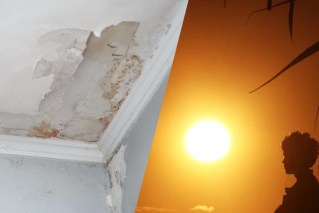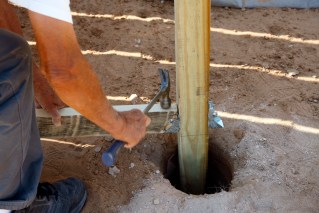Utopia hidden in plain sight: World’s first ‘perfect’ Radburn neighbourhood turns 50

From above, Crestwood looks unlike any other neighbourhood. Photo: State Library of Western Australia
A “catastrophe”, “total disaster”, a “crazy, ludicrous living hell” – that’s how politicians described some of Australia’s most radically designed neighbourhoods.
The design of the nation’s capital was based in part on the US town of Radburn, New Jersey, where back-to-front homes have front doors opening on public parks rather than the street.
In addition, fences are non-existent and circular streets twist around the neighbourhood, never intersecting with a winding network of footpaths.
The Radburn concept was visionary when it was used in Canberra and dozens of other neighbourhoods across the country in the 1960s and 70s.
But things didn’t quite work as planned, and many areas were transformed into crime-infested slums.
Many of those neighbourhoods were later bulldozed and rebuilt, but one shining example of a Radburn success story remains in the unpretentious southern Perth suburb of Thornlie and its residents are proud to have bucked the trend.

Crestwood’s houses are typically designed back-to-front, with homes facing public parks. Photo: Gian De Poloni
Original Radburn architect Clarence Stein reportedly described the community of Crestwood, 18 kilometres south-east of Perth’s CBD, as the “first perfect Radburn scheme in the world”.
“The people, the residents, the atmosphere – there’s no threats. You’re safe no matter what, I was happy here all the time,” said Rita Bernadette Fisher, one of the community’s first home owners.
The residents of Crestwood, who this month celebrated 50 years as a village, said their strong community spirit spared them from the crime and privacy issues typical of shared living.
“I will come home from work and there will be either two, three or four of our neighbours – they’ll end up on someone’s driveway and they’re having a good old yack,” said resident of 38 years Maria van der Linden.

Emile and Maria van der Linden have lived in Crestwood since 1982 and enjoy the heavy focus on community. Photo: Gian De Poloni
“When we go on holiday, they’ll look after our garden. We do that for each other. That’s really nice.”
“We just loved the layout of the place,” added Ms van der Linden’s husband, Emile.
“The kids can get to school without crossing any roads. You just go [through] underpasses all the way to school.
“After work you’d go and play with your kids out in the park – it’s just a marvellous place to bring kids up in.”

The entire neighbourhood is built around a community pool and function centre. Photo: Gian De Poloni
Utopia hidden in plain sight
A 1978 resident survey found 60 per cent of home owners were attracted to Crestwood by its aesthetics and 88 per cent were happier having moved there.
Most agreed there was more social interaction in Crestwood than standard suburban estates and said coming home at the end of the day was like entering a separate world.

A1978 survey of residents found 88 per cent of people who moved to Crestwood were happier living there. Photo: State Library of Western Australia
There were also some negatives to the shared spaces.
Some remarked living in Crestwood was “a bit like having to dress for dinner and always be watching your manners”, while several people commented on the implied social pretence in the area and the “existence of petty squabbles amongst residents”.
Dan McDonald and his family moved from rural Queensland to a home in Crestwood late last year.
“Something that has been surprising or not expected, and we really enjoy it, is that everyone knows each other,” he said.

Dan McDonald said the relaxed atmosphere of Crestwood had helped his daughter with her anxiety. Photo: Gian De Poloni
“Because we both came from rural backgrounds, well that’s a given for me that people talk to each other and that neighbours work together.
“But in the city, that’s unheard of or it seems strange, it seems unusual.
It seems so far that people here have mastered the art of living together, helping each other out without being too close.’’

Walkways connect the neighbourhood’s parks, with underpasses separating pedestrians and cyclists from roads. Photo: Gian De Poloni
There was also an unexpected, deeper benefit Mr McDonald and his family discovered.
“I felt lost in the city – I felt very detached and lonely even though I was surrounded by people,” he said.
“It doesn’t seem to be like that here – obviously it’s not a beer over the back of a ute, but people will stop and have a chat over the back fence, look at the dog, have a yarn about the garden.
“Our oldest has some learning difficulties and she has very bad anxiety. The surroundings almost fixed that.
“She’s a different child.”

Many homes in Crestwood still do not have fences. Photo: Gian De Poloni
As for living back to front: “No one can figure out how to get in our house … and we really like that!”
Where Radburn went wrong
The innovative Radburn design underpinning Crestwood was enthusiastically received by the governments of the day, which saw it as a progressive solution to public housing issues.
WA suburbs with high concentrations of state housing, such as Withers, Bentley, Karawara and South Hedland, were constructed using the Radburn blueprint, but this triggered huge social problems including burglaries, drug use and assaults.
Some of those suburbs were completely bulldozed and rebuilt in a more conventional style, while others are still pressing ahead with a so-called “de-Radburnisation” effort.

In 1998, parts of Karawara were redeveloped away from the Radburn neighbourhood style in an effort to reduce crime. Photo: Gian De Poloni
Planning Institute of Australia WA committee member Vicki Lummer said Karawara was an excellent case study in the flaws of the concept.
“There was a high percentage of state housing properties, which then set the tone for the socio-economic mix in that area and I think from the start that was the problem for Karawara,” she said.
“As time went by, all the design provisions were slowly eroded, so people weren’t doing low fences, and then the crime rates started to escalate because [the parks] then became unsafe areas to walk through.”
Peter Ciemitis, principal at urban planning specialists RobertsDay, said passive surveillance proved effective in reducing crime rates.
“With the inclusion of the high fences that people were starting to put in at Karawara, it actually made it a golden opportunity for crime because … the worst crimes happen behind a high fence.”

Peter Ciemitis and Vicki Lummer are both members of the WA arm of Planning Institute Australia. Photo: Gian De Poloni
The neighbourhood watch mentality is something Crestwood does well.
“When we moved in here hardly anyone had a back fence, but times change and gradually fences went up. But to me it just spoils the whole concept of it,” resident of 44 years Wendy Curtis said.
“We like to keep our fence open. I don’t care if everyone looks in at us, I like looking out at everyone else.”

Wendy Curtis moved into her Crestwood home in 1976 and enjoys her backyard being open to a public park. Photo: Gian De Poloni
Liz Griggs grew up in Crestwood and moved back as an adult with her children.
“It wasn’t until I got older that I really appreciated what I had as a child,” she said.
“There was children everywhere – we would have games and there would be 30, 40, 50 kids all participating from different parks, different age groups.

Liz Griggs grew up in Crestwood and moved back as an adult with her own children. Photo: Gian De Poloni
“The beauty of here is you look through your fence and out into the parks. It defeats the purpose, I think, having the big fence.
“I understand from a security point of view that that’s how some people feel, but then you may as well live anywhere.”
Size the key to keeping Crestwood on track
Crestwood was intended to be five times bigger than it is, with the addition of high-density apartment buildings and larger community facilities.
But the collapse of land values in the late 1970s and a drop in demand for lots meant that never eventuated and the surrounding land was developed in a more conventional style.

Crestwood targeted the higher end of the housing market and was initially planned to include eight distinct villages. Photo: State Library of Western Australia
Crestwood Homeowners Association secretary Kathrina Oakland said she wondered if expansion would have seen Crestwood implode.
“It would have just got out of hand,” she said.
“Whereas there’s only 295 of us and we all live here because we want to live here.”
Crestwood was initially marketed towards higher-income earners, with royalty-themed brochures bragging about blocks chosen by doctors, chemists, dentists, school principals and “a host of other discerning people”.

Crestwood was marketed as offering a ‘unique way of life’ for its prospective residents in the late 1960s. Photo: Gian De Poloni
It was also the first suburb in Perth to have underground power.
Mr Ciemitis suggested that niche appeal was why Crestwood never took off as a concept elsewhere.
“It’s not for everybody. They always seem to work as little gems, but it’s hard to just shift the whole marketplace into accepting that as a new living model,” he said.

The community has a British royal theme and was initially marketed at higher-income families. Photo: Gian De Poloni
Back to the future?
Some urban planners still believe the Radburn concept has its best days ahead.
“I think we have to learn from the successful parts of the Radburn design,” Ms Lummer said.
“All of the factors of climate change and people wanting to be more sustainable and having more green space, more tree cover – all of those things are coming together.”

Homes in Crestwood back on to a network of parks and pathways, a defining feature of the Radburn neighbourhood design concept. Photo: Gian De Poloni
Julian Bolleter, co-director of the Australian Urban Design Research Centre, said he believed Radburn neighbourhoods would come back in style in Australia.
“We need to be able to design suburbs that can funnel biodiversity,” he said.
“Radburn planning is very good on that front because you have uninterrupted spines of open space.
“I think our suburbs will have to get denser and they are getting denser, so we do need public open space and I think Radburn is a model that still remains valid in the right context.”

The Perth well-to-do inner-city suburb of Menora has Radburn principles, such as internal parks, that could prove valuable in the future. Photo: Gian De Poloni
Mr Ciemitis said inner city suburbs that incorporated Radburn principles, such as the Perth suburb of Menora, would prove valuable in the future.
“It might have in 50 years’ time a completely different life. That might be its golden year when it really works well,” he said.
“Just to get rid of these ideas sometimes is not the right approach – we might have the bones of something really quite spectacular.”








